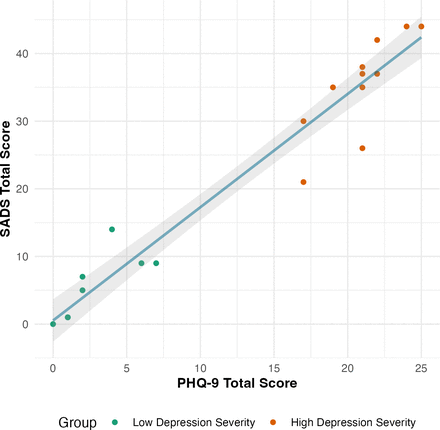Background
The South African Depression Scale (SADS) was recently developed by Andersen and colleagues1 2 as a screening tool for depressive symptoms specific to Xhosa culture. This scale was designed to assess classical symptoms of depression which are also measured by other tools such as the 9-item Patient Health Questionnaire (PHQ-9), including sleeping issues and anhedonia. Additionally, the SADS assesses more idiomatic expressions of depression, such as ‘having pain in my heart’ or ‘carrying a lot of weight on my shoulders’, which the PHQ-9 does not capture. The SADS has so far only been validated in South African cohorts of people living with HIV, but as this questionnaire was developed in both English and isiXhosa, it is possible to apply it to populations outside South Africa. Assessing the reliability of the SADS in other countries and cultures may further support the utility of this scale and enable comparisons with studies conducted in populations outside South Africa.
Methods
In this pilot study, we recruited n=20 adults living with HIV (median (IQR) age 50.5 (45.0, 54.0) years, 95% male, 80% self-identifying as White) in Brighton, UK. All participants were residing and receiving their regular HIV-related clinical care in Brighton, and none identified as Xhosa. To determine whether the SADS performed satisfactorily for participants with low or high severity of depressive symptoms, participants were recruited in two groups: low depression severity (PHQ-9<7, n=9) or high depression severity (PHQ-9>15 and a history of receiving antidepressant medication). All participants completed the PHQ-9 and the SADS in English during a single visit. In R v.4.3.2, we assessed the internal consistency of the SADS using Cronbach’s α, convergent reliability with the PHQ-9 using Pearson’s correlation coefficient (r) and item-level performance using descriptive statistics and item–total correlations. All participants had access to a dedicated HIV mental health service, including psychologists and psychiatrists, and were referred to this service if they exhibited suicide ideation or other symptoms which required referral.
Results
In our UK-based sample, the SADS exhibited high internal consistency, Cronbach’s α=0.975 (95% CI 0.955, 0.988). Total score on the SADS was strongly and significantly correlated with total score on the PHQ-9 (r=0.97, p<0.001) (figure 1).


Correlation between total score on the South African Depression Scale (SADS) and total score on the 9-item Patient Health Questionnaire (PHQ-9) for 20 adults living with HIV in Brighton, UK, with 95% confidence interval displayed in grey.
Item-level analysis indicated that most items of the SADS were strongly correlated with the total score (table 1). However, scores on SADS10 (‘I had pain in my heart’) and SADS11 (‘I cried’) were skewed towards zero and showed poor corrected item–total correlation (r=0.67 for SADS10 and r=0.48 for SADS11). Findings remained consistent when only including participants who self-identified as male.
Item-level analysis of the South African Depression Scale (SADS) for 20 adults living with HIV in Brighton, UK
Discussion
We observed high internal consistency for the SADS and high convergent validity between the SADS and PHQ-9 in a small UK-based sample of adults with varying depressive symptomatology. We also found that the SADS exhibited satisfactory item-level psychometric properties in our sample, except for two items (SADS10 and SADS11). Notably, SADS10 (‘I had pain in my heart’) was originally included in this scale to reflect a culturally specific idiom of distress and showed the highest factor loading among SADS items.1 Thus, the poor item–total correlation that we observed for this item in our UK sample was somewhat expected, and suggests that SADS10 may be specific to the South African (or more generally, African) context and not ‘translate’ well to expressions of depressive symptomatology in UK samples.
In our sample, SADS11 (‘I cried’) exhibited the poorest item–total correlation. Our participant sample was majority male, with all participants except one self-identifying as male. Gender roles, especially in cultures in the Global North, forbid crying for men,3 resulting in a measurable gender-based difference in reporting of crying as a symptom of depression.4 It is thus possible that the poor item–total correlation for SADS11 observed in our study was driven by the demographic (sex/gender) composition of our sample rather than being an artefact of cultural context.
Interestingly, all other items on the SADS displayed satisfactory psychometric properties in this pilot study, including SADS16 (‘I had deep sorrow’). SADS16 was added to the scale in consultation with isiXhosa-speaking mental health providers, and asks about a component of depression (‘isingqala’, loosely translated to ‘deep sorrow’) which is specific to the isiXhosa language.1 Nevertheless, this item showed a high item–total correlation in our study, suggesting that this idiomatic expression of depression may still be useful for assessing depressive symptoms among English-speaking participants in the UK.
In summary, we administered the SADS in a small sample of adults living with HIV in Brighton, UK, and found that this screening tool performed satisfactorily in the UK context. Our study was limited by a small sample size, and the majority of our participants self-identified as white. Given the small sample size and consequently limited statistical power, this study was also restricted to preliminary psychometric analyses. Despite these notable limitations, this pilot study offers early evidence that the SADS may be useful in the UK context. Establishing the utility of the SADS in populations outside South Africa is important for several reasons. First, this evidence can enable direct comparisons between studies of depressive symptoms carried out in South Africa (using the SADS) and outside South Africa (using other tools such as the PHQ-9). Second, it is possible that culturally inclusive tools such as the SADS may be effective at detecting depressive symptoms in communities of African origin residing in the UK and other countries in the Global North. Finally, as suggested by our findings, some idiomatic expressions of depressive symptoms may be understood by people across diverse cultural groups. By applying a screening tool that includes such idiomatic expressions in different populations, we may better distinguish between culturally specific and culturally agnostic features of depression.
Future work may seek to determine whether applying the SADS in other contexts may require excluding the highly culturally specific item SADS10, and whether this tool may be particularly useful for exploring depressive symptoms among African immigrant communities in the UK. In this instance, we did not ask participants directly about their perceptions of the idiomatic expressions of depression included in the SADS, but future studies should explore these perceptions, including through qualitative research methods. Validating the use of this screening tool in larger samples outside South Africa may enable cross-cultural comparisons of depressive symptoms.
Data availability statement
Data generated in this study (anonymised to protect participant identity) and R code used for data analysis are available publicly at <https://github.com/arishmr/SADS-UK-pilot>.
Ethics statements
Patient consent for publication
Ethics approval
This study involves human participants and was approved by the NHS London-Surrey Borders Research Ethics Committee (reference 22/LO/0546). Participants gave informed consent to participate in the study before taking part.
Acknowledgments
We thank Lisa Barbour and the clinical research team at the Clinical Research Facility of the University Hospitals Sussex NHS Foundation Trust (Brighton, UK) for their support in participant recruitment and data collection for this study.




